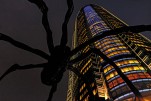Roppongi Hills

The Roppongi Hills mixed-use complex built in 2003 has become one of the most impressive projects demonstrating capabilities offered by the modern urban space. Despite the fact that its construction was finished more than ten years ago, this Tokyo district is still distinguished among others due to its unusual architecture, elaborated infrastructure and comfortable public spaces. The main vertical dominant of the architectural ensemble is Roppongi Hills Mori Tower that has become not only the important attraction in Japan but also entered the list of the highest buildings in the Land of the Rising Sun.
In the late 20th and early 21st century Japan pursued a policy of a financial “soap bubble” featured by multiple price growth on the securities and real estate market. As a result, the demand for commercial space already began to weaken since the beginning of the 1990s, and later there were numerous refusals to rent offices even in the most popular districts of large cities. With the course of time, the crisis in this sphere was only aggravated as many companies engaged in the construction of skyscrapers and mixed-use complexes did not finish started projects and left construction sites neglected. The government’s response to the situation was to grant loans for land purchase at a low interest rate and adopt flexible construction standards. These measures were meant to stimulate the interest of companies in less prestigious and attractive territories from the marketing perspective.
Large-scale projects intended to develop large districts were included in the agenda of state programs with a view to improve urban infrastructure, encourage private business investment in the formation of new blocks, etc. The first step in the implementation of measures for improving the territories was making a list of districts that required urgent reconstruction both within the main Japanese cities and around them. For instance, 24 central districts were chosen in Tokyo together with neighboring cities Yokohama and Kawasaki. The total area proposed to be renovated under the Japanese capital renovation program was 5,290 ha. First of all, the campaign provided for building high-rise residential complexes on the sites of old, overcrowded blocks. This would significantly increase the volume of housing, reduce its cost and vacate lands to arrange vast green areas there.
Full content of this issue you can read here
The full version of the article can be read in our printed issue, also you can subscribe to the web-version of the magazine
 Text by NINA KONOVALOVA
Text by NINA KONOVALOVA


